1

PPT Slide |
2

SRM Tutorial |
3

Prerequisite |
4

PPT Slide |
5
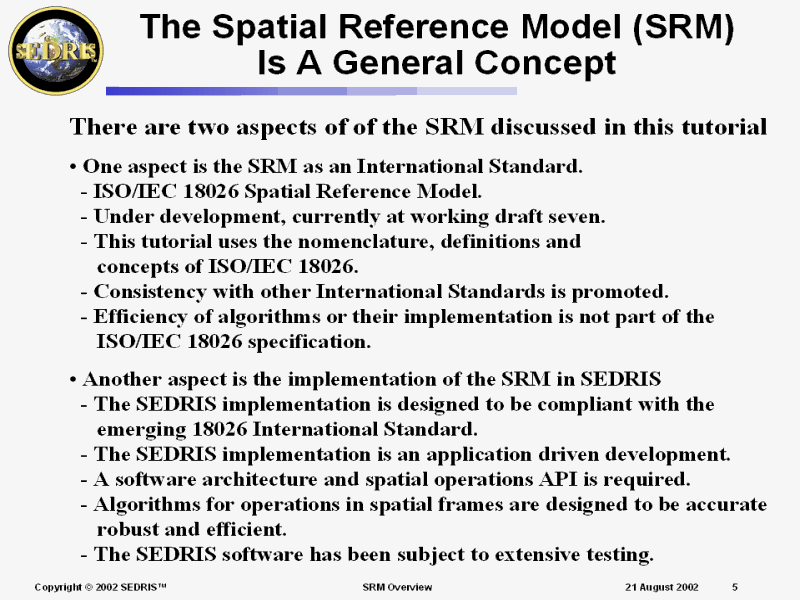
PPT Slide |
6

Section I |
7

In the Beginning ... |
8

PPT Slide |
9

Simulation Interfaces |
10

Other Interoperability Examples |
11

SRM Requirements |
12
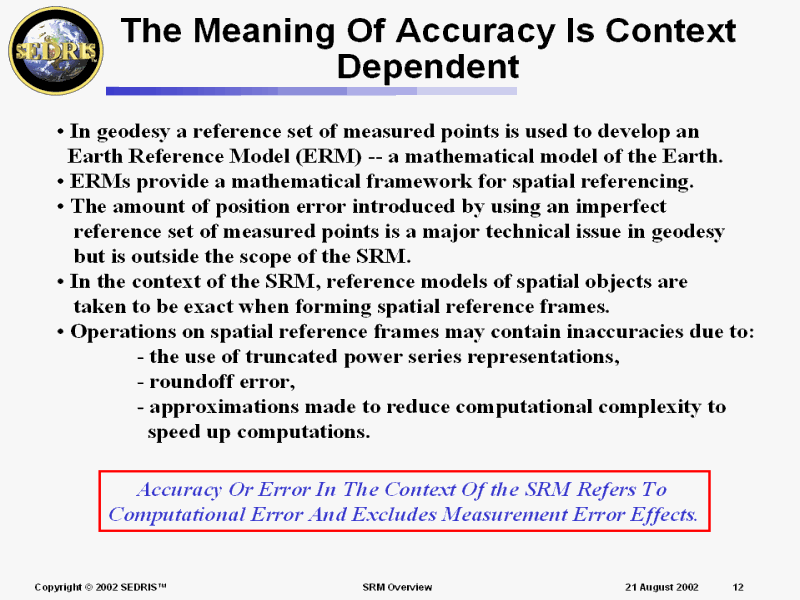
The Meaning Of Accuracy Is Context Dependent |
13

Why is Accuracy Needed
for Coordinate Transformations? |
14

PPT Slide |
15

It�s a Loooong Way Up |
16

The SRM Encompasses More Than The Earth |
17

The Scope Of The SRM |
18

The SRM Requires a Shared Solution |
19

Structure of the SRM ISO Standard |
20

Structure of the SRM ISO Standard |
21

Section II |
22

So How Will We Get There? |
23

Coordinates |
24

2-D Rectilinear Coordinate Systems |
25

Curvilinear Coordinate Systems(1 of 2) |
26
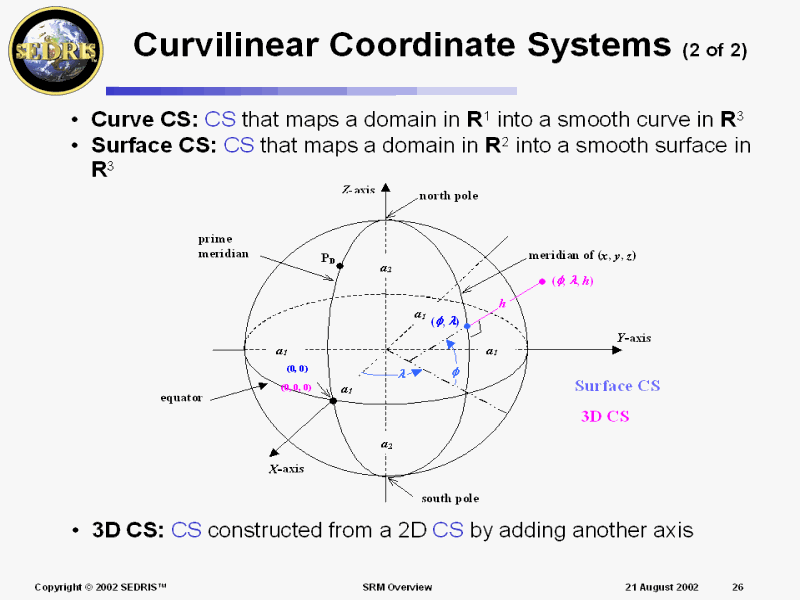
Curvilinear Coordinate Systems (2 of 2) |
27

Projection-based Coordinate Systems |
28

Spatial Referencing |
29

Indirect Embeddings |
30

Example: Vancouver_2002 |
31

Example: Vancouver_2002 Cont�d |
32

Example: Vancouver_2002 Cont�d |
33

Spatial Reference Frame |
34

Reference Datums (1 of 4) |
35

Reference Datums (2 of 4) |
36

Reference Datums (3 of 4) |
37

Reference Datums (4 of 4) |
38

Reference Datum Set |
39

Orthonormal RDS Class |
40

Oblate Spheroid RDS Class |
41

Infrastructure Review |
42

Section III |
43

Development of Surfaces
to Generate Maps |
44

Projecting from 2D to 1D |
45

Distance Distortion
Can Be Mitigated, Somewhat |
46
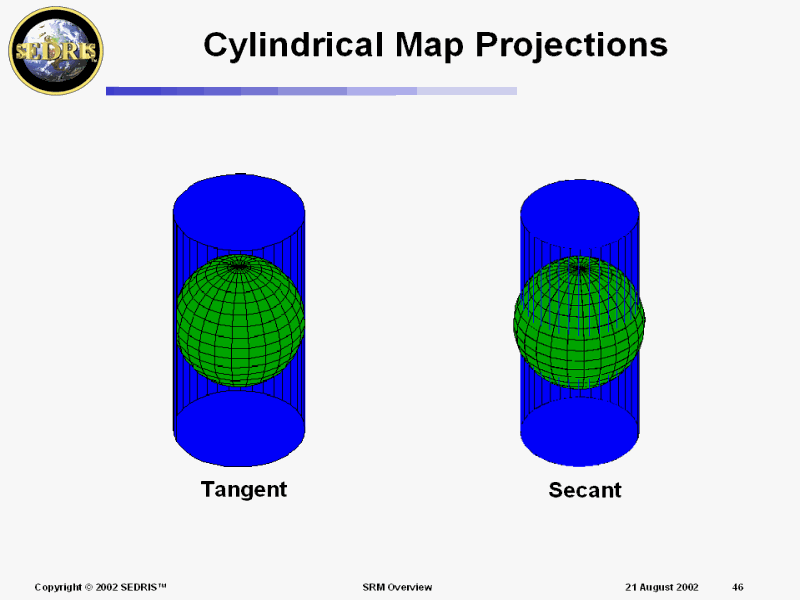
Cylindrical Map Projections |
47

Planar Map Projections |
48

A Stereographic Map Projection |
49

Conic Map Projections |
50

Mercator Map Projection |
51

Oblique Mercator Map Projection* |
52

The Grid for Transverse Mercator* |
53
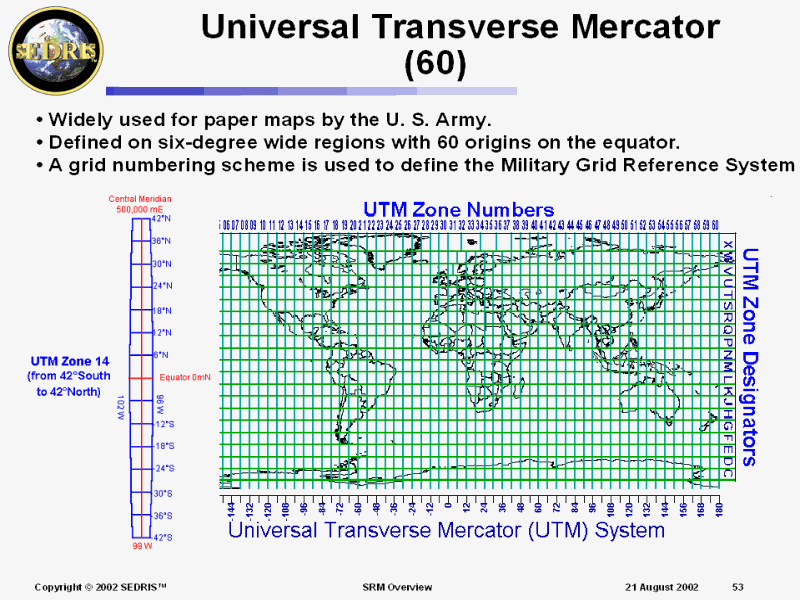
Universal Transverse Mercator (60) |
54

Lines of Constant Heading* |
55

Great Circle Arc between Moscow
and Washington D.C.* |
56

Augmented Projection-Based SRFs |
57

Projection-based �3D� SRFs |
58

The Use of Augmented Systems Changes
Geometrical Relationships |
59

SRF Operation Relationships |
60

Geometric Distortions |
61

Augmented map projection
vertical distortion |
62

Flattening the ORM:
Distance and Geometry |
63

Placing a Solid Cube on an OBS |
64

Doing the Math ... |
65

Placing a Cube on the
Topographic Surface Model |
66

Long Linear Structures |
67

Vectors in Augmented
Projection-based SRFs |
68

Vectors in a Curvilinear System |
69

Defining a Canonical
Local Tangent Plane SRF |
70
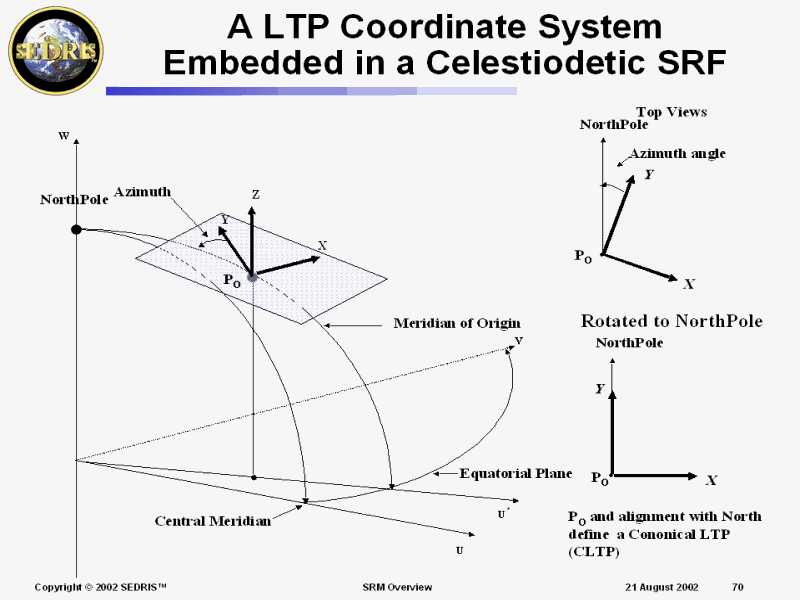
A LTP Coordinate System
Embedded in a Celestiodetic SRF |
71

Defining a CLTP
Embedded in a Celestiodetic SRF |
72

Reference Vectors |
73

Reference Vector Transformations |
74

Convergence of the Meridian |
75

SRF �North� may not be True North |
76
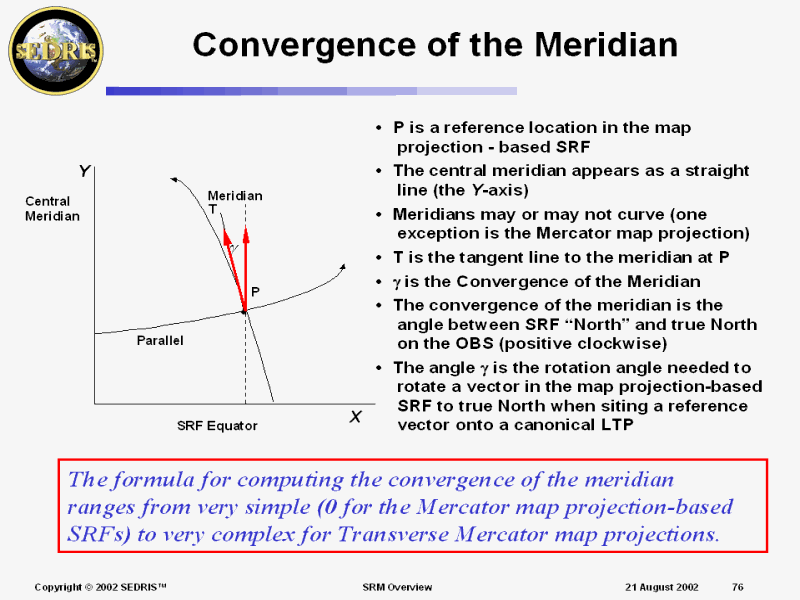
Convergence of the Meridian |
77

Section IV |
78

ORMs vs. Object Models |
79

Celestial Object Models |
80

Example: Earth |
81

Earth Surface Model Terminology |
82

Section V |
83

Spatial Operations |
84

Spatial Operations |
85

Coordinate Conversion |
86

Coordinate Transformation |
87

Spatial Reference Model |
88

Quality Assurance
for Spatial Operations |
89

Conformance Verification for the SEDRIS Implementation |
90

Acceptance Testing Methodology |
91

SRM Concept Management |
92

SRF Relationships |
93

Section VI |
94

Why is Accuracy Needed
for Coordinate Operations? |
95

Shooting at a Visible Target
in the Real World |
96

Simulation of Shooting
at a Visible Target |
97

Servicing a Non-visible Target
in the Real World |
98

Error Sources in Coordinate Operations Software |
99

Definition of Computational Error |
100

Numerical Methods |
101

Analytic (closed form) Solutions |
102

Taylor/Maclaurin Series Methods |
103

Iterative Methods |
104

Direct Approximation
of a Function or Its Inverse |
105

Direct Approximation of a
Function or Its Inverse (cont) |
106

Error in Power Series Expansions |
107

Error Analysis and
Resolution of Disagreements |
108

Effect of Small Errors |
109

Fuzzy Creep/Coordinate Drift |
110

Bounds Checking |
111

Distortion in
Map Projection-based SRFs |
112

Treatment of Point Scale |
113

Distortion and Computation
Error Tradeoff |
114

Distortion-Accuracy Tradeoff Experiment for TM |
115

Authoritative Sources Sometimes
Appear to Disagree |
116

Difference between SR-7 & Extended
Formulas for Transverse Mercator |
117

Transverse Mercator Map Projection Point Scale Equations |
118

Linear Distortion Error For TM |
119

Conclusions of Experiment |
120

What to Do? |
121

The Chaining Problem |
122

Section VII |
123

Modelers Often Prefer
Orthonormal Coordinate Systems |
124

Euclidean Distance
for an Orthonormal System |
125

Once the Environment is Included,
there are Many Feasible Paths |
126

Geometry Distorting 3-D SRFs
are often Used � Why ? |
127

Section VIII |
128

SRFs in the DRM |
129

DRM <Location> (Sheet 15) |
130

SRFs Supported |
131

Section IX |
132

PPT Slide |
133

ERM Datum Transformations |
134

WGS84 Geoidal Separation |
135

PPT Slide |
136

Types of Operation Errors |
137

�Valid� Coordinates |
138

Coordinate Validity |
139

Implementation Details (1 of 2) |
140

Implementation Details (2 of 2) |
141

Range Extension (1 of 2) |
142

Range Extension (2 of 2) |
143

PPT Slide |
144

Operation Implementation Status |
145

Coordinate Operation Chains |
146

Interface Specification(s) |
147

Status Codes (1 of 3) |
148

Status Codes (2 of 3) |
149

Status Codes (3 of 3) |
150

Operation Setup |
151

Change SRF Operation |
152

Multi-change SRF Operation |
153

Boundary Checking |
154

Operation Teardown |
155

Vector Operation |
156

Matrix Operation |
157

Convergence of the Meridian |
158

Further Reading |
. |
. |